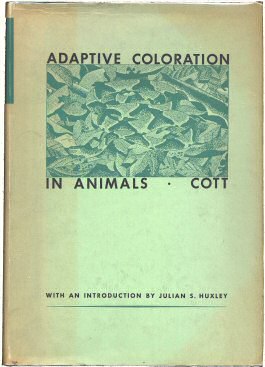
Adaptive Coloration in Animals
Adaptive Coloration in Animals is a 500-page textbook about camouflage, warning coloration and mimicry by the Cambridge zoologist Hugh Cott, first published during the Second World War in 1940; the book sold widely and made him famous.
Author
The book's general method is to present a wide range of examples from across the animal kingdom of each type of coloration, including marine invertebrates and fishes as well as terrestrial insects, amphibians, reptiles, birds and mammals. The examples are supported by many of Cott's own drawings, diagrams, and photographs. This essentially descriptive natural history treatment is supplemented with accounts of experiments by Cott and others. The book had few precedents, but to some extent follows (and criticises) Abbott Handerson Thayer's 1909 Concealing-Coloration in the Animal Kingdom.
The book is divided into three parts: concealment, advertisement, and disguise. Part 1, concealment, covers the methods of camouflage, which are colour resemblance, countershading, disruptive coloration, and shadow elimination. The effectiveness of these, arguments for and against them, and experimental evidence, are described. Part 2, advertisement, covers the methods of becoming conspicuous, especially for warning displays in aposematic animals. Examples are chosen from mammals, insects, reptiles and marine animals, and empirical evidence from feeding experiments with toads is presented. Part 3, disguise, covers methods of mimicry that provide camouflage, as when animals resemble leaves or twigs, and markings and displays that help to deflect attack or to deceive predators with deimatic displays. Both Batesian mimicry and Müllerian mimicry are treated as adaptive resemblance, much like camouflage, while a chapter is devoted to the mimicry and behaviour of the cuckoo. The concluding chapter admits that the book's force is cumulative, consisting of many small steps of reasoning, and being a wartime book, compares animal to military camouflage.
Cott's textbook was at once well received, being admired both by zoologists and naturalists and among allied soldiers. Many officers carried a copy of the book with them in the field. Since the war it has formed the basis for experimental investigation of camouflage, while its breadth of coverage and accuracy have ensured that it remains frequently cited in scientific papers.
The book[edit]
Approach[edit]
Adaptive Coloration in Animals is a 500-page book, 10 by 7 inches (250 by 180 mm) in its first edition. It was published by Methuen (in London) and Oxford University Press (in New York) in 1940. It is full of detailed observations of types of camouflage and other uses of colour in animals, and illustrated by the author with clear drawings and photographs. There is a coloured frontispiece showing eight of Cott's paintings of tropical amphibians. The book has 48 monotone plates and several illustrations.[P 1]
Cott's method is to provide a large number of examples, illustrated with his own drawings or photographs, showing animals from different groups including fish, reptiles, birds and insects, especially butterflies. The examples are chosen to illustrate specific adaptations. For example, the fish Chaetodon capistratus is described as follows:[P 2]
Reception[edit]
Foreword[edit]
Julian S. Huxley wrote a foreword (labelled 'Introduction') which defends the Darwinian concept of adaptation, especially of colour (in animals) and within that frame of mimicry. He makes it clear that "in these last thirty years" (that is, from about 1910 to 1940) he believed that "experimental biologists" professed, even if they did not actually hold, "a radical scepticism on the subject of adaptations", in other words about whether natural selection really could have created the enormous diversity of pattern and colour seen in nature.[P 12] Huxley quoted the now long-forgotten Aaron Franklin Shull's 1936 Evolution[2] which stated "These special forms [sexual selection, warning colours, mimicry and signalling] of the selection idea... seem destined to be dropped, or at least relegated to very minor places in the Evolution discussion.", and more sharply that "aggressive and alluring resemblance" (Huxley's words) "must probably be set down as products of fancy belonging to uncritical times."[2] Huxley's reply is simply[P 12]
Adaptive Coloration in Animals has been published as follows: